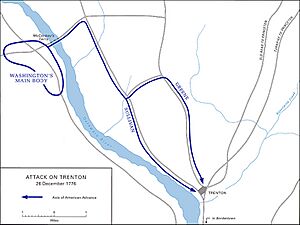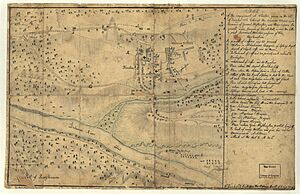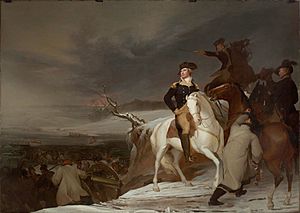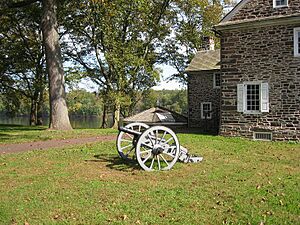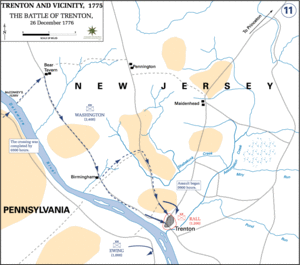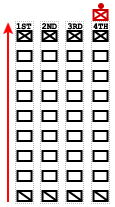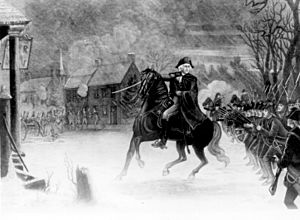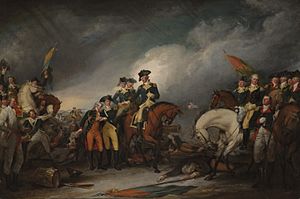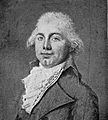Battle of Trenton facts for kids
Quick facts for kids Battle of Trenton |
|||||||
|---|---|---|---|---|---|---|---|
| Part of the American Revolutionary War | |||||||
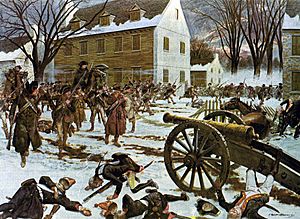 Battle of Trenton, H. Charles McBarron Jr. |
|||||||
|
|||||||
| Belligerents | |||||||
| Commanders and leaders | |||||||
| Strength | |||||||
| 2,400 | 1,500 | ||||||
| Casualties and losses | |||||||
| 2 dead from exposure 5 wounded |
22 killed 83 wounded 800–900 captured |
||||||
The Battle of Trenton was a very important battle during the American Revolutionary War. It happened on the morning of December 26, 1776, in Trenton, New Jersey. General George Washington led his army, called the Continental Army, across the Delaware River the night before. They attacked Hessian soldiers who were staying in Trenton.
Hessians were German soldiers hired by the British to fight against the Americans. After a short fight, the Americans captured almost two-thirds of the Hessian army. The Americans had very few losses.
Before this battle, the Continental Army had lost many fights in New York and had to retreat to Pennsylvania. The soldiers felt very discouraged. To lift their spirits, George Washington planned a surprise attack. He decided to cross the Delaware River on Christmas night, December 25–26, and surround the Hessians.
The river was full of ice, and the weather was terrible. This made the crossing very dangerous. Two groups of soldiers could not cross the river. This left Washington with only 2,400 men for the attack, which was much fewer than he had planned. The army marched about 9 miles (14 km) south to Trenton. The Hessians thought they were safe and were not watching carefully. Washington's army surprised them. Most of the Hessians surrendered, but about one-third escaped across Assunpink Creek.
Even though it was a small battle, this victory greatly inspired Americans who supported the new United States. Just a week before, many people wondered if the revolution would succeed. The army seemed like it was about to fall apart. This amazing victory encouraged soldiers to keep fighting and brought new people to join the army.
Contents
Why the Battle of Trenton Was Fought
In the 1760s, the American colonies wanted to be free from England. This led to the Revolutionary War in 1775. By 1776, American soldiers had been fighting for over a year. Their spirits were very low. The British and their hired Hessian soldiers had pushed the Americans out of New York. The Continental Army had to retreat across New Jersey. Many soldiers had left the army because they felt that winning independence was impossible. Even General Washington had doubts.
At this time, about 1,500 Hessian soldiers were staying in Trenton, a small town in New Jersey. These soldiers were led by Colonel Johann Rall.
On December 20, 1776, about 2,000 more American troops joined Washington's camp. Another 800 troops arrived from Fort Ticonderoga. Washington's army now had 2,400 men. Major Generals Nathanael Greene and John Sullivan led the foot soldiers. Brigadier General Henry Knox was in charge of the cannons.
Planning the Surprise Attack
Gathering Information
George Washington used a spy named John Honeyman to gather information about the Hessians. Honeyman pretended to be a loyal supporter of the British. He was a butcher and bartender who traded with the British and Hessians. This helped him learn about their plans. He also convinced the Hessians that the American army was too weak to attack Trenton.
Just before Christmas, Honeyman arranged to be "captured" by the American army. He was brought to Washington, who questioned him. This plan allowed Honeyman to give Washington important news without the Hessians suspecting he was a spy.
The American Plan
In the week before the battle, American soldiers attacked enemy patrols. They captured messengers and Hessian guards.
The American plan needed attacks from three different directions at the same time.
- General John Cadwalader was supposed to cross the river and attack the British in Bordentown, New Jersey. This would stop British help from coming and create a distraction.
- Washington's main force of 2,400 men would cross the river about 9 miles (14 km) north of Trenton. They would split into two groups. Generals Greene and Sullivan would attack before dawn. Sullivan would attack from the south, and Greene from the north.
- General James Ewing would take 700 soldiers across the river further south. He would capture the bridge over the Assunpink Creek to stop enemy soldiers from escaping.
Washington also ordered General Ewing to gather information on Hessian movements. Ewing made three successful raids across the river. Washington had soldiers watching all river crossings. He believed the British might attack if the river froze.
Hessian Preparations
On December 14, 1776, the Hessians arrived in Trenton for the winter. Trenton was a small town with about 100 houses. It had two main streets: King Street and Queen Street. Colonel Johann Rall was in charge of the Hessians in Trenton. His superior, Carl von Donop, had gone south to fight some New Jersey soldiers.
Some Hessian officers thought it would be smart to build defenses around Trenton. They suggested building a fort at the top of town and defenses along the river. They even drew plans. But Rall disagreed. When he was told again to fortify the town, he said, "Let them come...We will go at them with the bayonet."
As Christmas Day came closer, loyalists (people who supported the British) and soldiers who had left the American army told the Hessians that the Americans planned to cross the river. This news worried Rall. He wrote to his commanders, saying he felt the Americans could attack at any moment. He asked for British troops to help defend the roads. But the British said no.
The main Hessian force of 1,500 men was divided into three groups. That night, they did not send out any patrols because of the bad weather.
The Dangerous Crossing and March
Around 11:00 p.m. on Christmas Day, Washington and his soldiers began crossing the Delaware River. Each soldier carried 60 bullets and food for three days. They crossed in large boats called Durham boats. Horses and cannons crossed on big ferries. No one died during the crossing, and all the cannons made it safely.
The rain turned to sleet and then snow as temperatures dropped. This made the mission run very late. The crossing was supposed to be done by midnight but was not finished until 3:00 a.m. Washington realized it was too late to attack Trenton before dawn.
At 4:00 a.m., Washington's soldiers began marching toward Trenton. Some local people joined as volunteers and helped guide the army because they knew the land. The soldiers marched together and then split up. Greene's group went east to approach Trenton by the Scotch and Pennington Roads. Sullivan's group went southwest by River Road.
Many soldiers did not have boots. They had to wrap rags around their feet. Some men's feet bled, turning the snow red. Two men died on the march. Washington rode along the line, encouraging his men. General Sullivan sent a message to Washington, saying the weather was making his men's gunpowder wet. Washington replied, "Tell General Sullivan to use the bayonet. I am resolved to take Trenton."
About 2 miles (3 km) outside town, the main groups were surprised by armed men. But they were Americans. These men had not known about the attack plan and had just attacked a Hessian outpost. Washington worried that his surprise was ruined. However, the attack on the Hessian outpost actually helped Washington. Colonel Rall thought this first attack was the one he had been warned about, and that there would be no more fighting that day.
The Battle Begins
The American Attack
At 8:00 a.m., Washington led an attack on a Hessian outpost. An American soldier fired at the Hessian commander, but missed. The commander immediately shouted, "The Enemy!" and other Hessians came out. The Americans and Hessians exchanged fire. The Hessians began to retreat. The Americans pushed the Hessians, who were using houses for cover, to the edge of town. One Hessian group was near the Delaware River. This left River Road into Trenton open. Washington ordered his soldiers to block the escape route to Princeton. American cannons were set up at the start of King and Queen Streets.
General Sullivan led the southern American group into Trenton using the open River Road. He blocked the only crossing over the Assunpink Creek to stop the Hessians from escaping. Sullivan paused briefly to let Greene's group push the Hessians from their outposts in the north. Soon after, Sullivan's men continued their advance. The Hessians were pushed back, and 20 British soldiers also fled. Some tried to swim across the creek, while others escaped over the bridge before it was fully blocked. As Greene and Sullivan's groups moved into town, Washington went to high ground north of King and Queen Streets. From there, he could see the battle and direct his troops. By this time, American cannons from across the Delaware River were firing, destroying the Hessian positions.
When the alarm sounded, the three Hessian groups in Trenton got ready for battle. Colonel Rall woke up to find that the Americans had taken the main intersection of the town. This was where the engineers had suggested building a fort. Rall ordered his group to form up at the lower end of King Street. The American cannons and soldiers fired too much for the Hessians to fight back. The Hessian soldiers fell back and ran to a field. Many were killed by cannon fire and musket shots. Sullivan led a group of men to block the escape of the Hessian troops across the creek.
Hessian Resistance Falls Apart
The Hessians in the field tried to get organized again. They wanted to make one last try to take back the town so they could escape. Rall decided to attack the American side of the army on the heights north of town. Rall yelled, "Forward! Advance! Advance!" The Hessians began to move, with their band playing music to boost their spirits.
Washington, still on high ground, saw the Hessians coming toward the American side. He moved his troops into battle formation. The two Hessian groups marched toward King Street but were caught in American fire from three directions. Some Americans had taken positions inside houses. Civilians even joined the fight against the Hessians. The Hessian formations broke, and they began to scatter. Washington led his troops down from the high ground, shouting, "March on, my brave fellows, after me!" Most of the Hessians retreated into an orchard. The Americans quickly surrounded them. The Hessians were offered a chance to surrender, and they agreed.
Another Hessian group mistakenly marched in the wrong direction. They tried to escape across the bridge but found it had been taken by the Americans. Sullivan's men quickly surrounded them. This group surrendered just minutes after the rest of the Hessian army.
Who Was Hurt and Captured
The Hessian army lost 22 soldiers killed and 83 wounded. Between 800 and 900 Hessians were captured, including the wounded. The Americans only had two deaths during the march and five wounded in battle. Two important American officers were wounded: William Washington, who was General Washington's cousin, and Lieutenant James Monroe, who later became a President of the United States. Monroe was badly bleeding after a musket ball hit his left shoulder. A doctor stopped the bleeding, saving his life. However, other American soldiers died in the following days from tiredness, cold, and sickness.
Colonel Rall was badly wounded in the battle and died later that night. All four Hessian colonels in Trenton were killed. The Hessians lost many soldiers and much equipment. The Americans captured cannons, supplies, about 1,000 weapons, and much-needed ammunition. They also took all the Hessians' food supplies, like flour, meat, and drinks. They also got shoes, boots, clothing, and bedding. These things were very important for the American soldiers who were poorly equipped. The captured Hessians were sent to Philadelphia and later to Lancaster. In 1777, they were moved to Virginia.
What Happened After the Battle
On December 28, after the Hessians surrendered, General Washington learned that the other American generals, Cadwalader and Ewing, had not been able to cross the river. This meant Washington's tired army of 2,400 men was alone. Washington realized he did not have enough soldiers yet to attack Princeton and New Brunswick.
By noon, Washington's army had moved back across the Delaware River into Pennsylvania. They took their prisoners and captured supplies with them. Washington continued his success a week later in the Battle of the Assunpink Creek and the Battle of Princeton.
The Battle's Importance
This small but very important battle had a huge impact. The American victory at Trenton gave the Continental Congress new confidence. It proved that American forces could defeat professional soldiers. Soldiers re-enlisted in the Continental Army, and people became less afraid of the Hessians. Writings by Thomas Paine and successful actions by the New Jersey Militia also helped gain support for the American rebellion.
The Trenton Battle Monument, a tall monument in Trenton, honors this American victory. The crossing of the Delaware River and the battle are re-enacted by local people every year.
Many current U.S. Army units today can trace their history back to units that fought in the Battle of Trenton.
Famous Painting
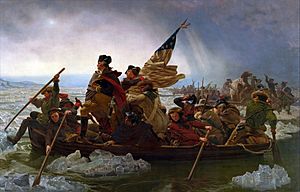
In 1851, a German-American artist named Emanuel Leutze painted a famous picture called Washington Crossing the Delaware. When it was first shown, it got a lot of attention in Europe and the United States. Leutze hoped it would inspire revolutionary feelings in Germany. The painting was shipped to New York City. A newspaper called it "the grandest, most majestic, and most effective painting ever exhibited in America." It is now in the Metropolitan Museum of Art and is one of the most famous American paintings. It is a central part of American historical art and is still very popular today.
Images for kids
-
The future president James Monroe fought in the Battle of Trenton alongside George Washington.
See also
 In Spanish: Batalla de Trenton para niños
In Spanish: Batalla de Trenton para niños


